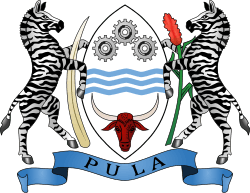Coat of arms of Botswana
| Coat of arms of Botswana | |
|---|---|
 | |
| Details | |
| Armiger | Republic of Botswana |
| Adopted | 25 January 1966 |
| Escutcheon | Argent, three barrulets wavy Azure; in chief three cogwheels proper arranged per chevron inverted; in base a bull's head affronté gules horned Argent |
| Supporters | Two zebras proper, the dexter holding an ivory tusk and the sinister holding an ear of sorghum. |
| Motto |
PULA "Rain" in Tswana |
The coat of arms of Botswana was adopted on January 25, 1966. The centre shield is supported by two zebras. The shape of the shield is that of traditional shields found in East Africa. On the top portion of the shield are three cogwheels that represent industry.
The three waves symbolize water, and reminds the viewer of the motto of the nation: pula, which means simply "rain", but also good luck, and is the name of the nation's currency. This motto also highlights the importance of water to Botswana. The motto is found at the bottom of the coat of arms on a blue ribbon.
At the bottom of the shield is the head of a bull, which symbolises the importance of cattle herding in Botswana. The two zebras also symbolise the importance of wildlife, through tourism, in the national economy . Also, zebra have black and white stripes which represent equality of people of all colors in Botswana. The zebra on the right holds an ear of sorghum, an important crop in the nation. The zebra on the left holds a tusk of ivory, symbolic of the former ivory trade in Botswana. There is also view that ivory tusk represents wild life preservation. Botswana has one of the highest elephant populations in Africa.
References
- Guide to the Flags of the World by Mauro Talocci, revised and updated by Whitney Smith (ISBN 0-688-01141-1), p. 165.